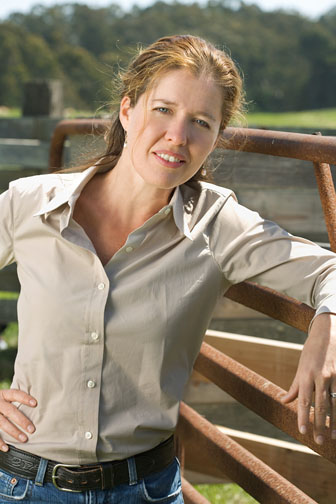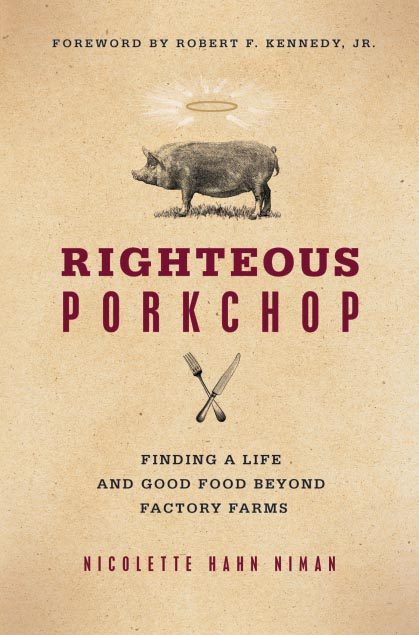 |
||
|
THE SMOKING POET |
||
|
|
|||
|
Eating Right and
Righteously By Nicolette Hahn
Niman I always considered myself
an enlightened eater, even long before I really was. I tried not to overeat,
watched fat content, and included lots of fresh fruits and vegetables in my diet. I had even become a vegetarian as a college
freshman. So I figured I was doing what was necessary to eat right. As a child, I’d spent time on farms and had witnessed my mother grow herbs and vegetables for our
table in her backyard garden. Yet as an adult, I rarely worried about what had
happened to my food before it landed on my plate. It seemed both unknown and unknowable.
How the hens that laid my eggs were fed and how they lived wasn’t on my radar screen. To a degree, this was willful ignorance. I vaguely suspected
that if I saw how those chickens were living, I wouldn’t like it. And then
what would I do? It was better not to know, or so it seemed. Then my job showed me what
the industrial food system looks like – and smells like, and I could no longer
ignore the shady past of my own foods. My eating habits were changed for good. It all started one evening in my home town of Within a year, I was in I threw myself into the work
of an environmental lawyer fighting pollution from industrial animal facilities. Meanwhile,
I re-examined my own eating. I didn’t want my consumer dollars supporting
animal factories and I sure didn’t want to put their products into my mouth. That was nine years ago. My diet has evolved a lot since then. But
one of the first things I discovered was that it could not be transformed overnight.
“Baby steps are okay, as long as they’re in the right direction,” a friend advised. And what wise words those were. Healthy eating, I now believe,
involves understanding the whole food chain – from farm to table – and seeking items produced in ways that are
in keeping with my values at every step along the way. Organic is good but only
the first question. Even more important is that food production be in harmony
with nature’s cycles and seasons. This means, among many other things,
that all animals raised for food should be given room to roam outdoors. In seeking out the right
foods, my starting premise has always been that I wanted to avoid the products of industrial animal operations. Simply put: I wanted all my foods to come from places that
I would enjoy visiting. This goal is difficult, but not impossible. Step one was to stop being a supermarket zombie. Fresh foods
from sustainable family farms are rarely found in supermarkets. The number of
farmers markets in the Three years after I started
Bobby Kennedy’s reform campaign I married Bill Niman, the founder of the natural meat company Niman Ranch, and moved
across the country to These days, I spend a lot
of time in the kitchen. I look at our meals as something that I can keep improving
over time. When I shop farmers markets and farmstands, I chat with farmers about
what they’re growing and how they like to cook it. I explore the market,
picking up the in-season fruits and vegetables, then experimenting with them when I get home.
We never compromise on the pleasures of eating as we strive to make everything we consume better. Long ago, Bill and I shifted to brown breads and rice. Lately,
we’ve switched to pastas made from whole grains, too. Getting to a diet that’s
good for my health and righteously produced is an on-going process. I consider
it all a great adventure. Nicolette
Hahn Niman is a lawyer, rancher, and author of Righteous Porkchop: Finding a Life and Good Food Beyond Factory
Farms. “A searing, and utterly convincing, indictment of modern meat production. But the book brims with hope, too, and charts a practical (and even beautiful) path out of the jungle.” —Michael Pollan, author, Omnivore’s Dilemma and In Defense of Food “This book is without a doubt the best piece of writing on animal agriculture I have encountered in 25 years of work in animal welfare and agriculture… [I]t is a totally captivating read.” —Dr. Bernard E. Rollin, Colorado State University, Distinguished Professor of Philosophy, Biomedical Sciences, and Animal Sciences Righteous Porkchop: Finding a Life and Good Food Beyond Factory Farms by Nicolette Hahn Niman Book Review by Zinta Aistars ˇ Hardcover: 336 pages ˇ Publisher: William Morrow, 2009 ˇ Price: $23.99 ˇ ISBN-10: 0061466492 ˇ ISBN-13: 978-0061466496 For many years, I thought
I had been doing the right thing, eating the right foods and watching out for my health. I thought I was an environmentalist,
caring about the preservation and good stewardship of the natural world we live in. Holy cow, was I wrong.
Some time ago, I was reading another good book about human behavior, and what is required for us to behave against our own values. Compartmentalization was a concept I came to understand is absolutely necessary for most of us to act in ways that are not in accordance to our own values. To do wrong, we must push out of our awareness the realization of consequences to our actions. We must stuff things into a locked away place and live in denial.
Picture the mind as
a house with many rooms, each with a door. Well, there was this room in my mind … and it had a door, and I had firmly
closed it. Inside that room was a vague realization that animal abuse was happening in order to put food on my plate. Gee,
I love that steak, that juicy burger, that slab of bacon! Did I really want to know how it got there? Now I know. The door
to that room is wide open, and I have no intention of closing it again. Once most of us are aware, most of us do change our
behavior. Most of us, when you get down to it, are pretty nice people. Most of us want to do the right thing and
we love our pets, we love the natural world around us, and we care to preserve it. So how is it that our supermarkets are filled with food produced in food factories, by an industrialized form of agriculture that is fast ruining our environment and obliterating a type of lifestyle many of us find admirable? How is it that we tolerate the cruelest forms of animal abuse imaginable? And consider this: we don’t have to. We can still enjoy that steak, sizzle that bacon, and chow down on that juicy burger. Yes, we can have our delicious porkchop and eat it, too. The person breaking
down my denial door is author Nicolette Hahn Niman. Assigned to write a story about food production and food activism for
the Kalamazoo College alumni magazine, I introduced myself to Nicolette when she (an alumnae) visited the college campus.
She was talking to a rapt audience about her new book, Righteous Porkchop. Slides illustrating
her experiences as a food activist working for Bobby Kennedy, Jr. added images to her words, and I’m pretty sure I could
hear doors flying open throughout that room. Niman had grown up in
And me? I’ve been
eating skinless chicken breasts that I purchased at the supermarket in frozen bags, along with salmon fillets, and only the
occasional chunk of red meat. That’s good, right? Wrong. Niman’s wake up
call was when she heard Bobby Kennedy, Jr. speak in In his foreword to Niman’s
book, Kennedy writes: “The waste from hog factories is prodigious. A hog facility
with 100,000 animals can produce the same amount of fecal waste as a city of one million people… Waste from these factories
can contain a witch’s brew of nearly 400 dangerous substances—including heavy metals, antibiotics, biocides, chemical
disinfectants, pesticides and disease-causing viruses and microbes.” A necessary evil? You
may be thinking … jobs in a lousy economy, maybe? Kennedy writes: “Each pig factory puts family farmers out of business, replacing high-quality agricultural jobs with hourly-wage
workers in degrading positions that are among the lowest paid and most dangerous in the But surely that nagging
global problem of hunger? Niman writes: “Global
food production has actually outpaced population growth. Every year the world produces enough wheat, rice, and other grains
to provide 4.3 pounds of food per person per day (including two and a half pounds of grain, beans, and nuts, a pound of fruits and vegetables, and nearly a pound of meat, milk, and eggs.) Moreover, in the last four
decades, per capita food production has grown 16 percent faster than the world’s population, meaning there is now more
food per person available on the planet than ever before in history. Clearly, abundance is not an issue.” I’m hearing a
chorus of belches at the buffet table by now, but it is coming from only one side of the table. Niman is right. We have only
to look around at our epidemic of obesity to realize the table has a shorter leg on one side, all the food sliding into one
set of mouths at one end of the table, while the other end is left high and dry. It is not about abundance; it is about distribution.
Hunger is about poverty. If people have the resources and the means with which to purchase or grow their own food, they will
not go hungry. This call is to focus our efforts where they belong—on eliminating poverty. So let’s get back
to what are the real issues at hand: the ills of industrialized food production. And I choose the word “ill” with
multiple purpose. To read Niman’s account, the results of her nationwide research, in-person visits to food factories
and feedlots and slaughterhouses is enough to make you ill. And it should. And it does. Because the abusive conditions of
these great numbers of confined animals, purposefully (and don’t doubt that purpose, just think “out of sight,
out of mind”) kept behind closed doors where most of us will never see what is really going on, is also making the animals
ill. Living creatures, no matter what kind, need a few basics to survive and thrive: fresh air, exercise, good food. Subtract
all of these, as industrialized food production does, and you have to substitute growth hormones, antibiotics, tranquilizers,
steroids, and a host of other drugs just to keep these animals alive. I stopped eating veal
decades ago. All it took was seeing one photograph. That photograph appeared in Time magazine, and I can see it vividly
in my mind still. It is a black and white photograph of a tiny newborn calf, standing wobbly and great-eyed in a wooden crate
which prevented any and all movement. That crate prevents movement because people like tender meat. That is, meat without
muscle. Get the picture? To prevent any movement that might develop muscle, that baby animal is crated for all its living
days so that you can eat a tender piece of veal. I was an easy convert. I already had one foot in the crate, or out of it. But Niman’s book led me into the immense metal barracks that hold battery cages of thousands upon thousands of chickens, the cages that hold pigs until they start to wave their heads back and forth and chew the air in what are visible signs of an animal going mad. Niman took me into the feedlot and the slaughterhouse, to realize that a disturbing number of animals are actually dismembered and gutted while still alive and fully conscious. Niman made me understand that we so little value the life of the chicken that after one year of holding these hens, their beaks cut off to prevent pecking each other out of stress, in cages so small that they cannot even turn around, that once they are considered “layed out,” they are sucked up into immense vacuums and dumped into bins with rotor blades to chop them up into mincemeat. Mind you, still alive. It's enough to make me put that drumstick down. And this is necessary
…. why? Which is Niman’s point. It is not only not necessary, it is, in fact, detrimental. This kind of food production is detrimental to animals, detrimental to human beings, detrimental to the environment. Wastes from confined animals end up in lagoons of liquefied manure that are often pumped into our water sources or allowed to seep into soil (the author writes about her helicopter adventures flying over these lagoons as food factory workers illegaly flush them into nearby rivers).
If you thought manure
was a terrific fertilizer, you are right. But not in these incredible quantities. On traditional farms—those that we
still try to sell to our children while singing ditties about Ol’ MacDonald had a farm—manure happens naturally,
in quantities that can be used in soil to grow crops, and with the addition of sunshine, killing harmful bacteria. There’s
a whole process there that works beautifully before we start super-sizing it and messing with it. Instead, we have Mad
Cow disease, and microbes flowing into streams and rivers and lakes. We have salmonella. We have noxious gasses that have
been increasingly connected to a long list of ailments in anyone unlucky enough to live anywhere in the vicinity of modern
agriculture. We have a growing mountain of evidence that industrialized farming is responsible for more climate-changing pollution
than the auto industry and the cars we drive. Add to that statistics showing
that Americans are throwing away more than half the food we produce in this country, and you can see that this is a recipe
for disaster. Just when I want to
go screaming down that hall of suddenly open doors that have revealed to me the horrors of food factories, however, Niman
lets some sunshine in the window. Yes, there is a better way. And we begin to understand that “progress” is not
always foreword movement. Sometimes it is regression. Sometimes we have to go back to that place in the road where we took
the wrong fork. Traditional farming
had it right all along. While there is always room for improvement, farming in a manner that raises animals in a humane and
healthy manner produces better quality food. In other words, if you don’t give a hoot about the pig, consider all that
flavor and nutrition you and your family are missing. Niman takes us from the feedlot into the gourmet kitchen, where chefs
across the country are discovering—or rediscovering, if you will—that foods coming from traditional farms taste
a lot better. Our palettes have become desensitized, but once you taste the difference between meat that comes from an animal that has been grazing on grass and eating healthy foods (you don’t even want to know how much animal poop is being used as feed for other animals, but you should know, because you are the next animal in line), you won’t want to go back. Ever tasted a greenhouse tomato and then taken a bite out of vine-ripened tomato? Then you have an idea what this food adventure is all about. It’s a flavor explosion. (Yes, I've been on a food adventure of my own since reading this book, and it's been truly delicious. I had no idea what I was missing.) Niman’s book is
unnerving. It pounds sense into our compartmentalized brains. Every lie we have come to believe about food is gutted. The
author shows us what is going on behind all those closed doors and hidden-away buildings. She gives practical advice about
how to shop organic, and what the labels mean and don’t mean. "Natural" is often anything but. "Organic," well, usually.
"Open-range" can mean the door is left open for a while on the food factory, or that a chicken foot may have touched cement
for a moment, but not earth. This is an exposé, and she encourages voting with your fork. Personally, I don’t
think I have ever encountered an easier crusade to join. It just tastes so darn good. The laws are mostly already in place,
Niman writes. It is just a matter of insisting our legislators enforce them. Government subsidies are supporting food factories
and helping to destroy traditional farms. Get the government out of the way, and organic food will be a lot more reasonable
in price. It’s a movement to reclaim our good health, live in a sustainable manner on our good earth, and simply to
do the right thing with respect to all living beings. Still not enough for
you? Okay, fine. Niman also tells a terrific love story. Ever heard of a vegetarian who falls in love with a cattle rancher?
Nicolette Hahn Niman is the wife of nationally respected cattle rancher Bill
Niman, formerly of Niman Ranch (you may see that on your menu at quality restaurants). The two (plus young son Miles) are
now living on a cattle ranch in There you have it. A delicious cause that will make you feel good, and right with the world, when you sit down to dinner. A love story with a happy ending. A well-written and interesting read that has just enough facts and figures to put it on solid ground, but not so dry that you won’t want to turn the page. My pages kept zipping by. A horror story that will keep you up nights, too, and should … but it is one you can change. Start with this important book—and start voting with your fork.
See also a book review of Righteous Porkchop by Olga Bonfiglio.
|
|||
|
Feedback, submissions, ideas? E-mail thesmokingpoet@gmail.com |
|||

